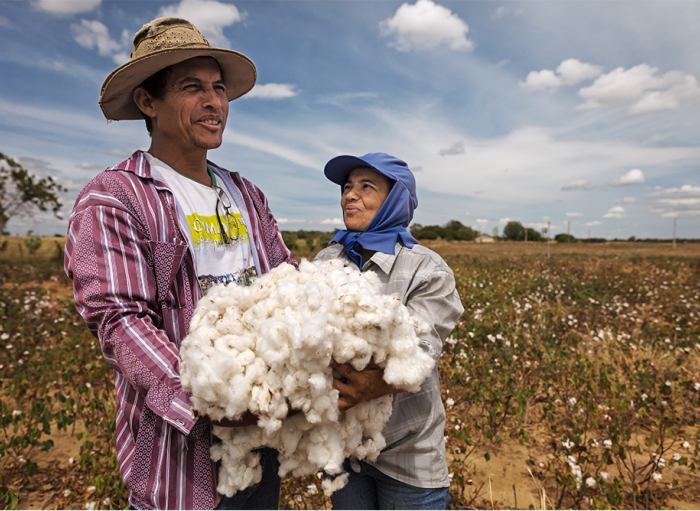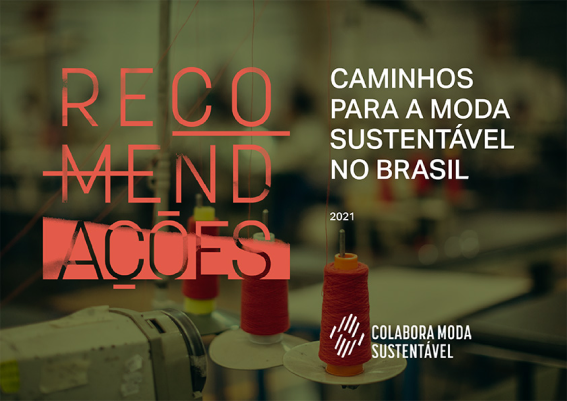
The fashion production chain is extensive, fragmented and distributed throughout Brazil, with many regional peculiarities. To transform the sector as a whole it is necessary to develop shared solutions and to engage various stakeholders – something that is already at the heart of our work as Colabora Moda Sustentavel.
In order to accelerate the resolution of diverse and complex social, economic and environmental challenges, we decided to work for many months on the drawing up of recommendations. When embraced, they can unlock and drive the progress of such solutions and change the sector’s main challenges, thus making Brazilian fashion more ethical and sustainable.
WHAT IS A RECOMMENDATION
A good recommendation is one that, if truly embraced, is transformative. For this reason, the recommendations presented here are not designed to be revoutionary or utopian, but are based on real, viable levers that are often in line with emerging movements of the ecosystem in question.
As well as being feasible and having the power to change, the set of recommendations is an important framework to build on, as joint progress generates mutually supportive effects, reinforcing and empowering new paths.
THE RECOMMENDATIONS HAVE INTENDED RECIPIENTS
In addition, recommendations must be individually addressed to stakeholders who play a major role or even have formal responsibilities in the matter, stakeholders who can influence other stakeholders, who are available and able to engage in dialogue and influence, and who have the ability to raise the profile of the agenda and create new facts and information that take discussions in the sector to a new level. No matter how complex an issue is, the recommended stakeholder has the ability to be effective.
THE PATH TO BUILDING THE RECOMMENDATIONS
To make them possible, the Recommendations for Sustainable Fashion in Brazil are being drawn up in a consultative and participatory process during 2021 – with analysis of national and international materials, in-depth interviews and public consultations. The process is overseen by Colabora Moda Sustentavel and carried out by Prowa Strategic Consulting.
The potential recommendations are based on knowledge that has already been built up by various international works – by international organizations (OECD, UN, ILO, European Union), the British Government, Civil Society Organizations (Ellen MacArthur Foundation, BSR), case studies of other international fashion ecosystems (Spain, Asia), among others.
For the Brazilian context, the analysis was based mainly on the extensive and consistent work we do at Colabora Moda Sustentavel, which has conducted its strategy and multi-stakeholder initiatives to achieve positive transformation in the fashion supply chain, from a systemic understanding of challenges, risks and opportunities, and the emergent and collaborative learning of solutions that bring benefits to all.

THE PROCESS OF BUILDING
THE RECOMMENDATIONS
Kick-off of Colabora Moda Sustentavel and identification of the 6 transformative axes: Education, Science & Technology; Employment and Equity; Environment; Culture & Consumption; Business Model; and Public Policies
Mapping of 65 ideas, experiences and possibilities that could become recommendations for addressing the transformative axes and their challenges, based on the documents of Colabora Moda Sustentavel and other national and international movements
Definition of 25 proposals for recommendations grouped into 5 major needs: 1. Developing the chain and the business environment; 2. Increasing the supply of capital; 3. Strengthening the Fashion Ecosystem and its Organizations and Stakeholders; 4. A favorable legal and regulatory environment; 5. Generating and Disseminating Knowledge
Nationwide public consultation on the Colabora Moda Sustentavel Recommendations – Pathways to Sustainable Fashion in Brazil
Collective construction of strategies for economic recovery with sustainability, one of the bases for building the recommendations
Interviews with experts and stakeholders with relevance to the issue – employees of companies and associations in the fashion sector, public and regulatory bodies, civil society organizations that support the agenda and public officials with relevance to the issue
Consultation and collection of contributions from Colabora Moda Sustentavel members, definition of 20 recommendations for sustainable fashion in Brazil
NOW IT'S YOUR TURN TO CONTRIBUTE TO THE CONSTRUCTION OF THIS IMPORTANT PROJECT!
READ the Colabora Moda Sustentavel recommendations thoroughly.
SHARE this page with your contacts. The more people with access to the recommendations, the better!
SET UP A PLAN to implement the recommendations in your work environment. Remember that if they are not embraced, they will not be effective.
GIVE PRIORITY to the strategies that are most connected to your line of work and advocate for change.
COLLABORATE with those who are working to maximize results and reach out to us if you want to build solutions and guidelines together.
In each of the categories below, you’ll find the details on the recommendations.
If you have any questions relating to information or terminology, you can consult our Glossary here.

Improving business models for a more robust chain – with fewer risks and increased development of the fashion, textiles, accessories and footwear industries – can foster a healthy competitive environment, guarantee rights and offer better working conditions for all workers, whether direct or indirect, and meet the expectations of consumers around the world for greater sustainability.
The related recommendations seek to make the chain more resilient, better qualified and more professional, and to encourage practices that reduce informality and bring social and environmental security to all.
It is possible to leverage and accelerate various technical, technological and social solutions that have already been mapped out and are being tested in the supply chain. To achieve this, it is necessary to attract and expand resources to foster new business models, the development and adoption of fair and sustainable technologies and productive arrangements in the Brazilian fashion supply chain. By targeting and expanding financial resources from different sources – governments, charities, banks, companies in the chain and investors.
In this regard, the recommendations seek to attract capital, expand lines of financing and increase the availability of philanthropic and otherwise non-philanthropic financial resources to foster more sustainable business models, technologies and productive arrangements.
In order to transform production chains into healthy and sustainable ecosystems of shared value – with a reduction in inequalities, a reduction in injustices, and the practice of corporate social responsibility – we must rely on stakeholders who are diverse in scope, size and maturity, with complementary knowledge and skills, and with the ability and predisposition to understand and build a positive mutual agenda. Systemic and collaborative solutions are more creative, generate more balanced and beneficial actions for the community and businesses, ensuring longevity for such solutions and social stability.
A fashion ecosystem is made up of stakeholders such as large-scale farmers and small-scale family producers of natural fibers, manufacturers of artificial and synthetic fibers, spinning and weaving mills, processors, apparel manufacturers, distributors and retailers, workers, including immigrants, from all these links in the textile chain in formal or informal working conditions, consumers, machinery suppliers, equipment suppliers, software producers, specialty magazines publishers, fashion trade shows; advertising agencies, worker protection bodies, regulators, civil society organizations, community and production group leaders, fashion designers, digital retail platforms, influencers, journalists, fashion editors, media, etc.
To tackle challenges, it is also necessary to act on the legal and regulatory environment, both public and private, considering opportunities to build and revise regulations and standards that demand minimum conditions, social and environmental responsibility, ethics and transparency, and that facilitate the sustainable development of the ecosystem. Having a favorable legal and regulatory environment is a key factor in fostering and encouraging the development and adoption of sustainable social and environmental practices throughout the chain.
We are unable to act on what we don’t know. Understanding the opportunities and effects of the fashion supply chain in Brazil is crucial for all the players to recognize their role and their potential to provide solutions. Disseminating knowledge and conducting regional and national strategies based on data are key to building assessment capacity and a sense of urgency on the chain’s social and environmental issues, seeking a structural change in consumption and production patterns through awareness, appreciation and social mobilization.

